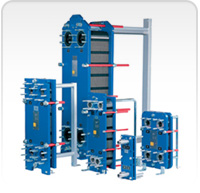 |
| The perfect choice to prevent fluids from intermixing that combines the high-efficiency heat transfer benefits of conventional plates with a design that eliminates the risk of mixing. |
|
| Salient Features |
 |
The double-wall design means that any leakage of either of the two fluids passing through the heat exchanger shows up on the outside of the heat exchanger, which can thus be taken out of operation for service.
Alfa Laval double-wall plate heat exchangers are therefore ideal for use with fluids that must not be allowed to mix because of the environmental effects, deterioration of process fluids or because it would be hazardous.
In steel mills, such situations include preventing cooling water being polluted by lubricating oils, hydraulic oils and cooling emulsions, as well as preventing water from contaminating these liquids. In electric arc furnaces, double-wall plate heat exchangers can be used to prevent water from getting mixed into the transformer oil cooling circuit, thus eliminating the risk of explosion.
| Advantages of double-wall plate heat exchangers |
 |
In addition to the major advantage of preventing intermixing of the two media used, double-wall plate heat exchangers are also superior to any comparable solutions, including double-wall shell-and-tube heat exchangers.
Double-wall plate heat exchangers achieve heat transfer coefficients that are normally two to three times higher than in shell-and-tube heat exchangers. This means that the heat transfer area required is significantly smaller, which in turn makes a crucial difference in terms of initial investment, especially when stainless steel or more exotic materials are needed. In addition, the low weight and compact design mean that installation costs are much lower.
|
|